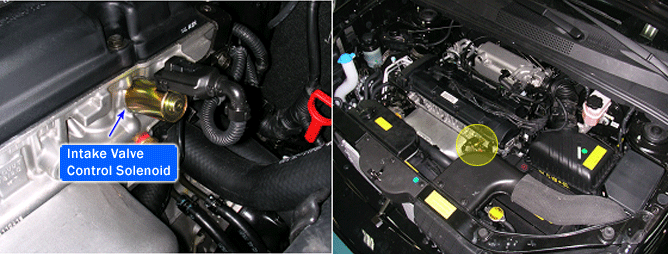

The CVVT (Continuously Variable Valve Timing) system is installed to the chain sprocket of the exhaust camshaft. There is no variation in valve timing of the exhaust cam because the exhaust camshaft is driven by the timing belt. The timing of the intake cam is varied by the relative operation the CVVT vane to the housing. This system helps the engine decrease exhaust gases and increase engine power and fuel economy by changing the valve open/close timing of the intake camshaft.
The deviation of the camshaft position from the target point is evaluated during stable driving condition. The PCM accumulats this deviation for a certain period and sets DTC P0011 when the accumulated deviation is too high. The target camshaft position is predetermineded value depending on engine speed and throttle angle in the PCM.
Item | Detecting Condition | Possible Cause |
DTC Strategy | ● Monitor deviation between camshaft position setpoint and actual value | ● Oil leakage ● Faulty Oil pump ● Faulty Intake valve control solenoid |
Enable Conditions | ● No relevant failure ● 11V < Battery voltage < 16V ● CVVT control : enabled ● Holding position adaptation not active ● Camshaft setpoint moved more than 5 times for this Driving Cycle ● Camshaft target position is stable with less than 1.125°CRK moving ● 600rpm < Engine speed < 5000rpm ● 20℃(68℉) < Engine oil temperature < 100℃(212℉) | |
Threshold Value | ● Integral of Camshaft position setpoint - Camshaft position actual value > 150°CRK/sec. | |
Diagnostic Time | ● Approx. 38~300 seconds depending on CAM deviation | |
Fail-Safe | ● CVVT control is disabled |
Intake valve control solenoid | Normal Parameter |
Insulation Resistance (Ω) | above 50 ㏁ |
Temp.(℃) | Temp.(℉) | Resistance(Ω) | Temp.(℃) | Temp.(℉) | Resistance(Ω) |
0 | 32 | 6.2 ~ 7.4 | 60 | 140 | 8.0 ~ 9.2 |
10 | 50 | 6.5 ~ 7.7 | 70 | 158 | 8.3 ~ 9.5 |
20 | 68 | 6.8 ~ 8.0 | 80 | 176 | 8.6 ~ 9.8 |
30 | 86 | 7.1 ~ 8.3 | 90 | 194 | 8.9 ~ 10.1 |
40 | 104 | 7.4 ~ 8.6 | 100 | 212 | 9.0 ~ 10.4 |
50 | 122 | 7.7 ~ 8.9 |